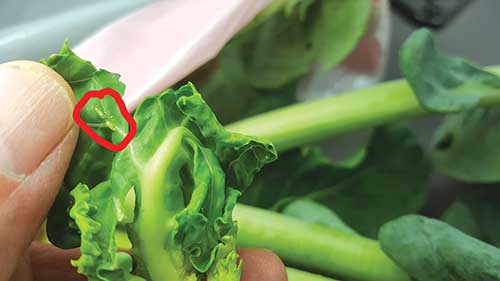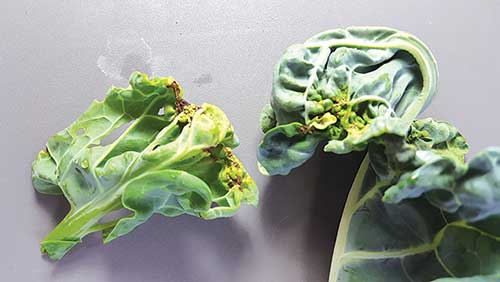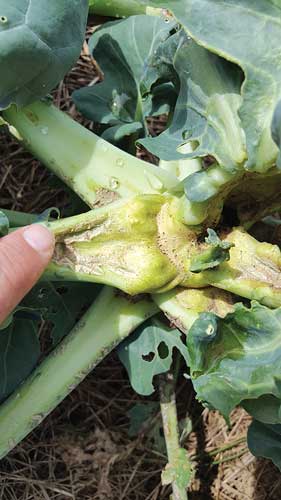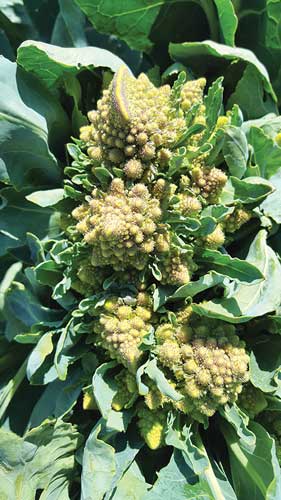 |
| Swede midge larvae, circled |
 |
| Broccoli leaves contorted by swede midge larvae feeding |
 |
| Swede midge damage in broccoli |
 |
| Multiple heads of Veronica cauliflower – a result of swede midge feeding |
By Caleb Goossen, Ph.D.
Photos by David Fuller
Over the coming years, farmers and home gardeners in Maine will likely encounter damage on their brassica plants from a new invasive pest, the swede midge (Contarinia nasturtii). The first year or so of its presence often goes unnoticed, but un-recognized populations can quickly build up and devastate brassica crops, including radish, horseradish, rutabaga, turnip, rapeseed (canola), arugula, and Asian greens such as bok choy and Chinese cabbage. However, crops that suffer the most from this new pest include common favorites such as broccoli, cauliflower, cabbage, kale, kohlrabi, collards and Brussels sprouts.
The name “swede midge” frequently leads to confusion. “Swede” does not refer to Sweden but to the rutabaga, more commonly called a swede in the United Kingdom. “Midge” is more self-explanatory: The adult form of this pest is a tiny fly, no more than 2 mm long. There’s not much point in detailing the adult form of this midge, however, as it typically lives for only a few days – just long enough to find a mate and lay eggs on a suitable host plant.
The swede midge is a newer invasive pest here, first arriving in Ontario, Canada, in the year 2000, and then spreading to the United States in New York state in 2004. The pest has continued spreading, and distribution modeling suggests that it could eventually establish itself in much of eastern North America. The swede midge was identified in two locations in Maine for the first time last summer, although it likely arrived at least a year prior and hadn’t built up enough of a population to cause noticeable crop damage.
Life Cycle
While as few as one swede midge larva feeding on a cauliflower plant at a certain stage of development can ruin the salability of a cauliflower head before it develops, small infestations often leave smaller, less noticeable signs of damage from their feeding. No organic spray materials have shown good efficacy with high populations. Therefore, disrupting the swede midge lifecycle is the most impactful aspect of organic management, so understanding its biology is critical.
When adult swede midges have mated, they quickly seek a host plant from the brassica family on which the female lays 2 to 50 eggs, and each female lays up to 100 eggs across laying sites. The host plant may be a crop plant, a cover crop or one of the common weedy brassica species such as shepherd’s purse, pennycress, wild mustards, wild radish, pepperweed or yellow rocket. Females typically lay eggs at the newest growth point on a plant, such as the terminal bud, or an axillary bud where a leaf meets the stem. When eggs hatch in a few days, tiny larvae (maggots) emerge and begin feeding on the host plant. This is the stage at which crop damage occurs. The larvae feed by secreting digestive enzymes and then ingesting liquid cell contents that have been exposed.
This feeding can damage or completely destroy the growing point. In the worst cases, damage to single-stemmed heading brassica crops such as broccoli, cauliflower and cabbage looks as if the plants have been pinched back, preventing a single large head from forming (“blind head”), which can cause the plant to send out small side shoots instead. Less-extreme damage can appear as a corky callus where feeding occurred, or as swollen, twisted or distorted growth where damaged tissue expands as the plant attempts to grow normally. Because feeding damage can vary greatly depending on where the larvae feed on the plant and on the stage of plant development, it can be confused with many other issues – from heat stress to molybdenum deficiency to “cultivator blight” (mechanical injury from weeding).
After they are fully grown, larvae “flip” off the plant and enter the top layer of soil (within the top inch) to pupate. They then emerge from the soil as adults within a week or two, depending upon soil temperature and moisture, and fly off to find mates and start the cycle over again. At the end of the growing season, pupae remain dormant in the soil, overwintering to emerge as adults the following spring, around May. A small portion of overwintering pupae may remain dormant in the soil for more than a year, emerging the spring after that (1 1/2 years after initially pupating).
Control
Adult swede midges are poor fliers. This fact, combined with overwintering in the soil under the plants they fed upon, makes crop rotation and row cover the most effective management strategy. An ideal crop rotation would use a distance of at least 1,000 feet (over half a mile is best). Farmers and gardeners who don’t have the luxury of far-flung fields should remember that crop rotation also includes time, and simply abstaining from spring brassica crops in the year following fall brassicas, or vice versa, can limit suitable host plants on which emerging adults can lay eggs. Row cover or exclusion netting will then prevent adult midges from laying eggs on your crop, should they be able to find it.
Remember that adults are weak fliers, but that also means they can be blown to your crop from nearby. Conversely, planting in a very windy location may actually help keep them off your crop.
Another idea deserving investigation is placing a well-sealed silage tarp over spring ground where brassicas grew the previous year. In theory, emerging adults become trapped under the plastic and are unable to fly to find mates, reducing the resident population.
Try the above strategies with careful consideration to nearby non-crop brassica host plants (i.e., weeds). Weeds can act as a refuge for swede midge, undoing your careful work of starving them out. Note also the chance of a small population emerging from pupae the following year – pupae that may have remained dormant the entire previous season.
Watch for unusual symptoms in your brassica crops and aim to have a management plan in place before the swede midge population builds to a very damaging level (which can happen quickly), but verify that the damage is in fact swede midge. When in doubt, try to find the larvae yourself, or contact your local Cooperative Extension office or me. This pest has just begun to infiltrate the state of Maine, although it has reached at least as far as Farmington coming from New Hampshire or Quebec and recently crossed into Aroostook County from New Brunswick. It will likely appear in new areas only in small initial numbers over the next few years as it spreads, but remember that populations can build quickly.
For more information, see the MOFGA Pest Report, and for comprehensive further reading, see the swede midge information center website.
Caleb Goossen is MOFGA’s organic crop and conservation specialist. You can contact him at [email protected].
